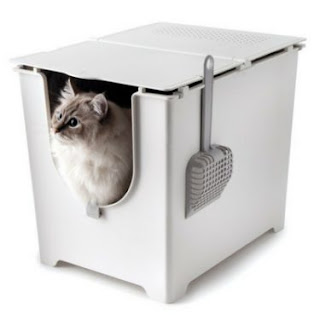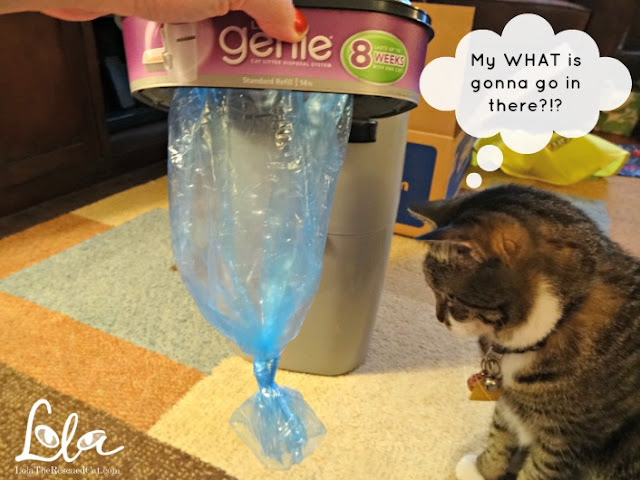Lola and Lexy's Top Five Litter Box Tips
Lexy: I agree, Lola. I think it’s quite outstanding.
Lola: Okay, let me tell you all what it is. Drumroll, please…… *chases tail in a circle*
Lexy: While Lola is making herself dizzy, allow me to elaborate. Lola and I are starting a series on the blog called “Lola and Lexy’s Top Five.” We’re going to talk about different subjects and give you our top five tips, or the top five reasons, or the top five ways…. you get the picture.
Lola: It’s going to be just great! I’m so excited to be taking over the blog again.
Lexy: To start it all off, today we have our Top Five Litter Box Tips.
Lola: We hope you enjoy it!
Lola and Lexy’s Top Five Litter Box Tips
1. Have the Right Number of Boxes
2. Location is Everything
- Place the litter box in an area where your cat spends the majority of their time, and this may mean the living room. While the idea of having a litter box in the living room is not ideal to many people, there are attractive boxes on the market, and even litter cabinets if necessary. Placing the box in an area that is hard to reach or in a place where your cat feels unsafe can lead to letterbox issues. You know that old saying “out of sight, out of mind?” If the litter box is out of sight you may be less likely to remember to clean it regularly.
- If using multiple boxes, they should be placed in different areas of the house. Avoid placing boxes side by side.
- Your cat should have an “escape route” from the box. Feeling like they’re “cornered in” can cause your cat to feel threatened and create fear of using the box and lead to litter box issues. If you live in a multi-cat household and there is the occasional (or frequent) “litter box stalking”, making sure your cat feels like that have a safe exit will make them feel more secure.
- The box should be placed away from your cat’s food and water. Instinctively, cats do not like to urinate and defecate near where they eat. Think of it this way… would you like to be served your dinner in the bathroom? Exactly. Keeping everything separate also reduces the chance of bacteria from getting into your cat’s food and water, which can make them ill. If they do have to be in the same room allow for five feet between them.
3.Choose the Right Box
The Right Size
The size of the box matters and may be the most important factor to consider. You want the box to be large enough so your cat can fit comfortably and have enough room to turn around. Remember these two rules of thumb when choosing the right size:The box should be at least 1.5 times the length of the cat from the nose to the base of the tail OR The box should be at least as long as your cat, from their nose to the tip of their tail (when extended), and its width should be at least as wide as your cat is long (with their tail not extended).
The Right Height
If you have a senior cat, or a cat that has mobility issues or arthritis (or even if you have a kitten), you’ll need a box that is very low in the front (approximately 2.5 to 3.5 inches high).If you have a cat that is a “sprayer”, kicks a lot of litter out of the box, has bad aim, etc., look for a box with three sides that are high enough (around 8 to 12 inches) to prevent urine, feces and/or litter from getting on the floor and one side that is low enough (around 5 to 6 inches) so your cat can get in and out easily.
Covered or Uncovered?
If you decide to try a covered box, make sure the opening is large so your cat can enter and exit easily. Regular scooping should be done since the cover can trap odors inside. We have the Modkat Flip litter box. The top flips back which leaves the box only half covered, and provides some extra room for us to stand up. It’s a win-win situation for all of us here at the White House.4. Choose the Right Litter
Let’s face it. Cats and humans have different preferences when it comes to litter. We cats prefer smaller, odor free particles while humans prefer litter that is low- tracking, low-dust, clumps well, and controls odors. You and your cat need to meet somewhere in the middle. You may scoop our… umm.. poop, but you’re not the one actually using the box.
Cats prefer litter with finer particles because it feels better on our paws. Before litter was invented cats did their business outside and covered it up with dirt or sand. And we have very sensitive noses and heavily perfumed litter can be a real turn-off to us. (Luckily our mom doesn’t like a scented litter, either.) Luckily, we found a litter, Boxiecat, that checks of the boxes for all of us.
It may take some trial and error to find the right litter, but once you find it, stick with it. If you do have make a change, make sure to do a gradual change over.
5. Keep it Clean!
Cats are very clean creatures by nature, and a dirty litter box is a turnoff for us. Having to tiptoe around our clumps to find a clean spot is no fun at all. Imagine if you had to do that? We need your help to keep our box an inviting place to go to the bathroom.
Create a Routine
If you put scooping the litter into your daily routine you’re more likely to do it regularly. Our mom does it in the morning after Lola gets her meds and dry food, and in the evening before she goes to bed. This way it’s always done and our box is always clean. And don’t forget, a complete change should be done once per month (with a good wash of the box) or more frequently if needed.
Keep everything you need to do the job right near the box. This includes the scoop, bags to put the dirty litter in (our mom either uses our Litter Genie or poop bags.), small dustpan and broom, etc. If everything is right at your fingertips litter box maintenance will be a breeze!
Do you have any other tips? Tell us about them in the comments.
We hope you liked our first Top Five post!
Keep Supplies Handy
Keep everything you need to do the job right near the box. This includes the scoop, bags to put the dirty litter in (our mom either uses our Litter Genie or poop bags.), small dustpan and broom, etc. If everything is right at your fingertips litter box maintenance will be a breeze!
 |
| Pin Us! |
Do you have any other tips? Tell us about them in the comments.
We hope you liked our first Top Five post!










Post a Comment